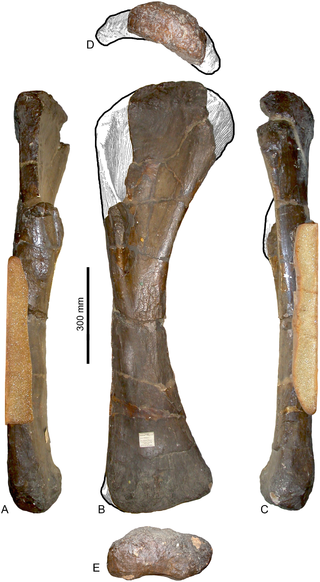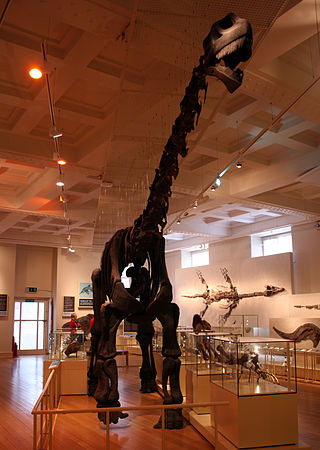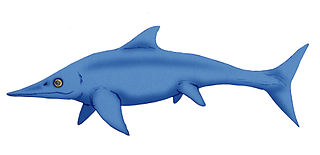
A holotype is a single physical example of an organism, known to have been used when the species was formally described. It is either the single such physical example or one of several examples, but explicitly designated as the holotype. Under the International Code of Zoological Nomenclature (ICZN), a holotype is one of several kinds of name-bearing types. In the International Code of Nomenclature for algae, fungi, and plants (ICN) and ICZN, the definitions of types are similar in intent but not identical in terminology or underlying concept.

In biology, a type is a particular specimen of an organism to which the scientific name of that organism is formally attached. In other words, a type is an example that serves to anchor or centralizes the defining features of that particular taxon. In older usage, a type was a taxon rather than a specimen.
In binomial nomenclature, a nomen dubium is a scientific name that is of unknown or doubtful application.

Pelorosaurus is a genus of titanosauriform sauropod dinosaur. Remains referred to Pelorosaurus date from the Early Cretaceous period, about 140-125 million years ago, and have been found in England and Portugal. Thomas Holtz estimated its length at 24 meters.

Temnodontosaurus is an extinct genus of ichthyosaur from the Early Jurassic period. They lived between 200 and 175 million years ago (Hettangian-Toarcian) in what is now Western Europe and possibly Chile. It lived in the deeper areas of the open ocean. University of Bristol paleontologist Jeremy Martin described the genus Temnodontosaurus as "one of the most ecologically disparate genera of ichthyosaurs," although the number of valid Temnodontosaurus species has varied over the years.

Cetiosaurus meaning 'whale lizard', from the Greek keteios/κήτειος meaning 'sea monster' and sauros/σαυρος meaning 'lizard', is a genus of herbivorous sauropod dinosaur from the Middle Jurassic Period, living about 168 million years ago in what is now Europe.

Cetiosauriscus is a genus of sauropod dinosaur that lived between 166 and 164 million years ago during the Callovian in what is now England. A herbivore, Cetiosauriscus had — by sauropod standards — a moderately long tail, and longer forelimbs, making them as long as its hindlimbs. It has been estimated as about 15 m (49 ft) long and between 4 and 10 t in weight.

Ornithopsis was a medium-sized Early Cretaceous sauropod dinosaur, from England. The type species, which is the only species seen as valid today, is O. hulkei.

Stenopterygius is an extinct genus of thunnosaur ichthyosaur known from Europe. This genus of ichthyosaur was about 3–4 meters long and weighed 150–310 kg (330–680 lb).

Pliosaurus is an extinct genus of thalassophonean pliosaurid known from the Kimmeridgian and Tithonian stages of Europe and South America. Their diet would have included fish, cephalopods, and marine reptiles. This genus has contained many species in the past but recent reviews found only six to be valid, while the validity of two additional species awaits a petition to the International Code of Zoological Nomenclature. Currently, P. brachyspondylus and P. macromerus are considered dubious, while P. portentificus is considered undiagnostic. Most species of Pliosaurus reached 8 metres (26 ft) in length and 5 metric tons in body mass, while P. rossicus and P. funkei may have reached or even exceeded 10 metres (33 ft) in length and 11 metric tons in body mass, being the largest plesiosaurs of all time. Species of this genus are differentiated from other pliosaurids based on seven autapomorphies, including teeth that are triangular in cross section.

Aegirosaurus is an extinct genus of platypterygiine ophthalmosaurid ichthyosaurs known from the late Jurassic and early Cretaceous of Europe. It was originally named as a species of Ichthyosaurus.

Brachypterygius is an extinct genus of platypterygiine ophthalmosaurid ichthyosaur known from the Late Jurassic of England. The type species was originally described and named as Ichthyosaurus extremus by Boulenger in 1904. Brachypterygius was named by Huene in 1922 for the width and shortness of the forepaddle, and the type species is therefore Brachypterygius extremus. The holotype of B. extremus was originally thought to be from the Lias Group of Bath, United Kingdom, but other specimens suggest it more likely came from the Kimmeridgian Kimmeridge Clay of Kimmeridge Bay, Dorset, UK.

Eretmosaurus is an extinct genus of plesiosaur.
Suevoleviathan is an extinct genus of primitive ichthyosaur found in the Early Jurassic (Toarcian) of Holzmaden, Germany.

Arthropterygius is a widespread genus of ophthalmosaurid ichthyosaur which existed in Canada, Norway, Russia, and Argentina from the late Jurassic period and possibly to the earliest Cretaceous.
This is a list of terms and symbols used in scientific names for organisms, and in describing the names. For proper parts of the names themselves, see List of Latin and Greek words commonly used in systematic names. Note that many of the abbreviations are used with or without a stop.

Malawania is an extinct genus of basal thunnosaur ichthyosaur known from the middle Early Cretaceous of Iraq. Malawania was named by Valentin Fischer, Robert M. Appleby, Darren Naish, Jeff Liston, Riding, J. B., Brindley, S. and Pascal Godefroit in 2013 and the type species is Malawania anachronus. It is unusual as it is much more primitive than other Cretaceous ichthyosaurs, being most closely related to Ichthyosaurus from the Late Triassic and Early Jurassic, over 70 million years earlier than Malawania, with all other known ichthyosaurs from the Late Jurassic onwards belonging to the family Ophthalmosauridae.
"Ichthyosaurus" posthumus is a species of ichthyosaurs known from the Late Jurassic Solnhofen Formation of Bavaria, Germany. Though several specimens have been referred to this species in the past, its type specimen consists only of isolated teeth that were destroyed during World War II, and it is today considered a nomen dubium. The teeth almost certainly do not belong to Ichthyosaurus itself, which was a wastebin taxon at the time this species was named.

This timeline of ichthyosaur research is a chronological listing of events in the history of paleontology focused on the ichthyosauromorphs, a group of secondarily aquatic marine reptiles whose later members superficially resembled dolphins, sharks, or swordfish. Scientists have documented ichthyosaur fossils at least as far back as the late 17th century. At that time, a scholar named Edward Lhwyd published a book on British fossils that misattributed some ichthyosaur vertebrae to actual fishes; their true nature was not recognized until the 19th century. In 1811, a boy named Joseph Anning discovered the first ichthyosaur fossils that would come to be scientifically recognized as such. His sister Mary would later find the rest of its skeleton and would go on to become a respected fossil collector and paleontologist in her own right.






















